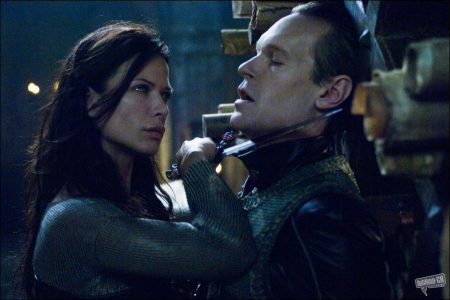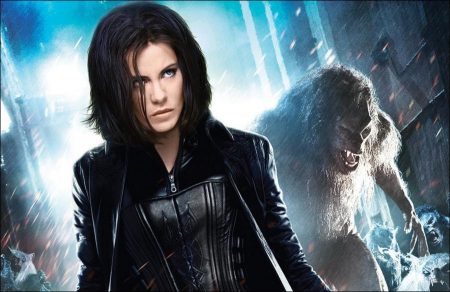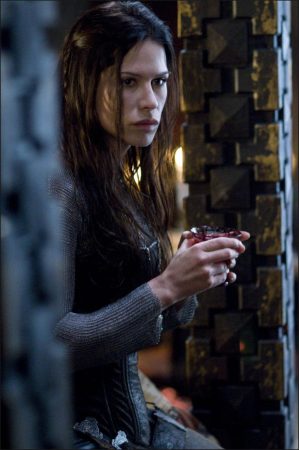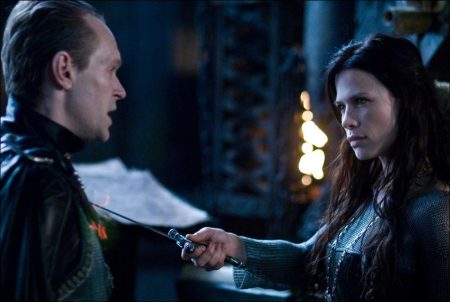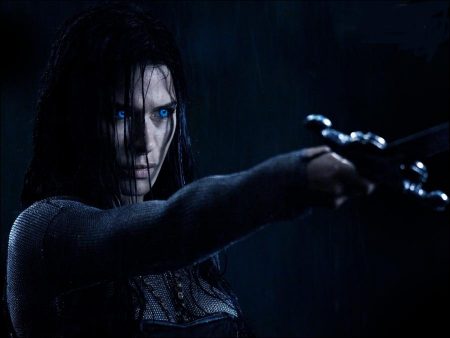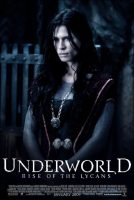Tagline: Every war has a beginning.
More than a thousand years before the events of the original Underworld, two races of preternatural beings came into being, each springing from the bloodlines of a different son of the original Immortal, Alexander Corvinus. Vampires, arising from the Markus line, became elegant, aristocratic, cunning blood drinkers.
Werewolves, from the William line, became savage beasts, with no trace of humanity left – and an insatiable appetite for violence. The Vampires came to dominate the local region – the wild lands in what is now western Hungary – with their superior intelligence, strength, and political skill. But even they feared the werewolves, who, though incapable of organization and higher thought, were capable of immense strength and savagery.
And then another genetic fluke transformed the balance of power again: a female werewolf, captive in the Vampire stronghold, gave birth to a seemingly human child. This was Lucian (Michael Sheen) – the first Lycan, born into slavery in the house of Viktor (Bill Nighy), the supremely powerful Vampire leader.
Unlike “William’s Kind”, the original werewolves, this Lycan was able to take the form of either man or beast at will. Lucian’s bloodline was used by Viktor to create an entirely new breed of slaves, abused by the Vampires as laborers and guards during the vulnerable daylight hours, and prevented from transforming by the silver-spiked moonshackles kept locked around their necks.
Viktor reigns over his slaves, his court and his domains with an iron hand. He loves only two things: power, and his beautiful but willful daughter Sonja (Rhona Mitra). Each night, Sonja rides with the Death Dealers, an elite squad of Vampire soldiers that protect Viktor’s domain against the marauding werewolves. But unknown to her father or any of her peers, Sonja has fallen in love with Lucian, now a skilled blacksmith and weapons-maker in the Vampire castle. Their affair must be conducted in the utmost secret, since if discovered, it would mean certain death for both of them.
When Lucian reveals that he has found a way to remove his moonshackle and gain his freedom, Viktor resolves to destroy him like a disobedient animal. In a thrilling sequence, Lucian manages rally the other Lycans and escape from the Vampire dungeons – with Sonja’s help. Refusing to abandon his beloved, Lucian assembles a ragtag army of escaped Lycans, slaves and werewolves, returning to challenge Vampire rule and rescue Sonja. The attack and its aftermath ignite an all-out war that will burn between the races for centuries to come.
About the Production
When Underworld debuted in 2003, its richly imagined telling of a centuries-long war between two immortal races wowed audiences across the globe. Ruthless Vampires and savage werewolves returned in its sequel Underworld: Evolution, and a worldwide audience devoured its elegant visual aesthetic, eerie characters and compelling action.
Now Underworld: Rise of the Lycans takes fans back almost a millennium to the beginning of an epic conflict. Created by longtime friends Len Wiseman and Kevin Grevioux, the film reveals the secrets at the heart of the Underworld saga’s eternal battle. Wiseman, who directed the first two films, has taken on the duties of producer for this installment, while Grevioux returns for the third time in the role of Lycan enforcer Raze. “The history has always been a driving force for Underworld,” says Wiseman. “In the past, we’ve had glimpses of how it all started. Now we’re finally able to play it out with the Death Dealers and their armor and the horses and masses of werewolves.”
Even before the first film was shot, the pair created a complex mythology for their Vampire and werewolf antiheroes. “Kevin and I always intended this to be a trilogy,” says Wiseman, now a sought-after director of films including Live Free or Die Hard. “It was decided at the time to start with the middle story in the timeline, and it is pretty cool now to be doing the prequel that we talked about so long ago.”
“A big part of the whole Underworld series is that the events that have taken place over the last eight centuries determine what’s happening in the present,” says producer Richard Wright. “There are whole sequences in the first film that are devoted to back story. And in the second film, the whole visit to the Tannis character’s lair is eight minutes of back story.
Grevioux wrote the original screenplay with Danny McBride. “Len wanted to do a werewolf movie and asked me if I had any ideas,” he says. “When we started hashing out characters and the overall structure, we thought: ‘What if we did a Romeo and Juliet story, with werewolves on one side and Vampires on the other and make it a cool, surrealistic modern-day love story?’ We also decided to change the way werewolves and Vampires have traditionally been looked at and go more for a scientific basis for their existence, rather than the traditional mysticism.”
Underworld: Rise of the Lycans traces the origin of the age-old rivalry between the Lycans and the Vampires to its ancient beginnings in a forbidden relationship. Lucian (Michael Sheen) is the first Lycan, a creature able to transform from werewolf to human and back again at will. Sonja (Rhona Mitra) is a Death Dealer and the daughter of Viktor (Bill Nighy), a powerful Vampire Elder. “Their relationship actually leads directly to the Lycans’ revolt against the Vampires,” explains Grevioux. “Everything revolves around the fact that Sonja and Lucian are in love with each other. Even though Sonja is Viktor’s daughter, there is an uncontrollable bond that grows between them. That already makes it a different kind of story from the first two stories.”
For the first time in the franchise’s history, Wiseman has turned over the director’s reins to someone else. Patrick Tatopoulos, creator of the first film’s fantastical and frightening creatures, as well as the production designer of the second, was selected to succeed him. Although he says he was happy to pass the torch to someone who has been integral to creating the franchise, Wiseman admits that it was strange at first to see someone else in the director’s chair. “I am seeing it happen from a different seat, but because Patrick and I have a relationship and we’ve built this thing together, it is a very easy atmosphere with us.”
Costumes, Creatures, Crypts and Castles
From the start, the Underworld films have been defined by their edgy, stylish visuals, reflected in every aspect of the film from wardrobe and sets to cinematography. In Underworld: Rise of the Lycans, the filmmakers have reinvented the franchise’s signature look with small and large innovations that reflect the film’s epic scope.
After initially considering Romania, the traditional home of the vampire, as the location, the filmmakers decided to shoot in New Zealand, a country with an internationally renowned filmmaking infrastructure thanks to films such as the Lord of the Rings trilogy. New Zealand’s breathtaking landscapes and lush green forests provided the perfect backdrop. “My first reaction was that New Zealand would be too beautiful,” says Tatopoulos. “It’s too gorgeous, too green. We could never do anything evil there. But on our first scouting trip, we saw Woodhill Forest, which looks like a dead forest. When I saw that, I knew it would be great.”
Instead of simply recreating the de-saturated blues and dark, brooding interiors of the first two Underworld films, director of photography Ross Emery brought new depth to the visuals. Because the story is set in the distant past, the mysterious cyan blue hues have been overlaid with a brassy burnished look that gives the third film a period feel. “The first films had very modern fittings, such as fluorescent lighting, but our world here is one of candles, braziers and moonlight,” says Emery. “That gives a much warmer light. We really went for yellows and brasses and mixed in some green to complement the moss and lichen in the external locations.”
And for the first time, the story moves out into daylight. That is a pivotal narrative point, as producer Wright explains. “Lucian’s character develops in big ways in this film, and one of those is finally getting out of the castle, finally getting away from the dominance of nighttime. When he gets out into the world, into greenery and blue skies, it’s a big moment. Suddenly color enters the world.”
Underworld: Rise of the Lycans is the first of the series to be shot in high definition. “For this kind of picture, HD worked perfectly,” says Emery. “It’s a very dark film because Vampires only come out at night. We only had a couple of weeks of exterior scenes in the entire movie. In that kind of environment, HD works beautifully.”
HD also allowed Emery to manipulate the speed of the action for the fight sequences and to enhance the werewolves’ appearance slightly. “We found that the werewolves looked much more menacing and violent when they were shot with a 45° shutter. All their movements look sharper and more aggressive,” he says. “I love HD because you can see what the film is going to look like on set,” says Emery. “You don’t have to imagine what it will be after grading and everything. For a visual person like Patrick, it’s fantastic because he could see on the monitors how the final film will look onscreen. That was a tremendous tool for everyone on the crew because they were able to make adjustments accordingly.”
Emery credits the film’s art department for making his job easier. “All I had to do with these sets was show up and turn on the lights. They were so beautifully detailed and the scenic artists, the construction guys, the finishers and dressers all did fantastic work. It makes my job so much easier when I walk onto a set and literally everywhere I put a camera, it looks fantastic.”
Production designer Dan Hennah is the Academy Award-winning art director of the Lord of the Rings trilogy. “One of the bonuses of this job was working with a really visual director,” he says. “Coming from the background of production design and creature design, Patrick could see what he wanted, and that’s always helpful.”
Tatopoulos insisted that the film’s design avoid the Gothic conventions of the vampire genre. “The film is set in a pre-Gothic period,” says Hennah. “The major influences were Georgian architecture, stone architecture from the borders of Russia, and a Byzantine Turkish influence. I guess it’s sort of a rock opium den!”
Tatopoulos wanted the main set, the castle, to be a massive structure carved out of rock that looms ominously over the characters. While the building itself was created through CGI, the team built the castle courtyard wall and castle façade where most of the action happens. Construction took eight weeks in a huge warehouse studio in South Auckland and employed a team of hundreds of carpenters, painters and plasterers.
“It is very much an underground environment,” says Hennah. “The concept was that the Vampires had taken over an old castle or monastery hewn out of rock and were converting it to their use. That accounts for the slaves and the construction.”
The castle gate is adorned with skulls, a reference to the ancient practice of parading severed heads publicly as a warning to law-breakers and enemies. The skull motif is also chiseled into the rock face over the courtyard, along with carvings that recall Russian Georgian art and Celtic symbols.
Hennah’s master creation is the crypt, an imposing circular room that was painted to simulate intricate mosaics of rich golds, yellows, greens and reds. “If it’s not painted properly, it’s not believable,” says Tatopoulos. “And the finishes on the set were of an incredibly high standard.”
Costumes have been a critical style element in each installment of the Underworld series. For Underworld: Rise of the Lycans, the designers created a new and unique look. The filmmakers wanted something for Sonja that would be warrior-like and sexy, as well as practical for the action sequences. Wendy Partridge, who designed the costumes for the first two Underworld films, produced an outfit featuring thigh-length boots, a leather corset and body armor with chain mail for the fight scenes.
“I don’t know if anyone’s actually ever seen anything quite like it,” says Mitra. “It’s another level in terms of costumes. How anything can look so incredibly masculine but at the same time really sassy is a puzzle. It was a nightmare to put on but I think that it’s worth it, because every time I stepped out of my trailer, I felt like, ‘I am this character.’”
Designer Jane Holland created costumes for the rest of the cast. For Holland, working with Tatopoulos was one of the great pleasures of her career. “He had such a strong sense of where we were going in a visual sense,” she says. “He was so able to express his ideas and he can draw beautifully and quickly. He obviously had strong pictures in his head, but he was open to what we brought to him.
“We were doing a lot of hand-crafted stuff, a lot of leatherwork, metalwork, some beautiful tailoring and a lot of hand-finishing,” she continues. “It’s really exciting to do that and great when you’ve got somebody who appreciates the detail.”
After consulting with Tatopoulos, Holland came up with a concept that combines medieval history references with pure fantasy. For the Vampire council members, Holland created opulent and decadent designs in rich fabrics such as velvet, while the enslaved Lycans were clad in tattered leather and the human characters wore costumes made of burlap.
“Patrick’s image of the Vampires was that they were sleek and narrow, and able to move quickly,” explains Holland. “I worked with that silhouette. They ended up being very tailored. Because we were dealing with night and a dark palette, we used a lot of black and dark colors. We used leathers and textures that would catch the light.”
Viktor’s four outfits include his signature costume, a long cashmere black frock coat with an ornate embroidered collar, cuffs and hemline. He also wears a leather-look waistcoat, tabard and skirt, his ornate armor and a skull helmet.
Lucian and the other slaves were clothed in distressed and aged leather, as if it were a second skin. It was also flexible enough to allow Michael Sheen maximum movement during the demanding fight scenes.
“They do a lot of the work for you,” says Steven Mackintosh of the costumes. “When you walk onto a set in these clothes and see a huge great hall or a courtyard with flaming torches and gateways and portcullises and torture chambers and dungeons, it makes the visual element of this film fantastic. I describe my costume as a cross between Richard the Lionhearted and Black Sabbath, which I think sums it up. It’s medieval, but it’s rock ’n’ roll too.”
Underworld: Rise of the Lycans features several intense, high-octane action scenes, including a one-on-one duel between two powerful Vampires, a bloody encounter between a Death Dealer and werewolves, and the epic Lycan and Vampire battle, which culminates in a final face off between Viktor and Lucian. In order to prepare the actors for the movie’s many challenging action scenes, stunt coordinator Allan Poppleton trained extensively with them before and during production.
Michael Sheen spent several weeks preparing for the role. “I enjoy sword fighting and that kind of stuff, so this gave me an opportunity to do all that. I’ve always considered myself to be a very physical actor and I try to bring as much of that to the character as I can. And given that I was wearing very little at certain points of the film, the more I jumped around when it was cold, the better!”
The fight between Viktor and Sonja was filmed on the castle courtyard set while a rain machine created a raging storm. “We spent most of a week bashing around in the rain with swords and character contact lenses,” Mitra says. “Every time you looked up water got in your eyes and the contact lenses rolled around. “My costume was difficult to work with in the rain,” she adds. “The chain mail was like a cheese-grater on my arms. It was all about being sodden and wet and looking like a drowned rat and trying to look sexy and cavalier!”
Tatopoulos describes the final scene as a clan battle where the stakes are high and the players will fight to the death. A combination of animatronic creatures, live performers and CGI was used to crowd the battlefield with werewolves and Lycans, creating a nightmarish showdown between the Vampires’ superior weaponry and the werewolves’ innate ferocity.
Coming from the creature world, Tatopoulos used the animatronic devices as much as possible, turning to CGI to amplify the effects. “It was very challenging,” recalls the director. “We had to create a sense of the immensity of the fight when we actually had four Lycans and four werewolves. Only two of those guys were mechanical, which means they could move in the shot.
“I found myself framing shots around which of the creatures actually moved,” he says. “I am a strong supporter of the mechanical creatures, but you also need to leave a little space for the CGI, which is in a sense more controllable. I think we found just the right balance.”
Underworld 3: The Rise of the Lycans (2009)
Directed by: Patrick Tatopoulos
Starring: Michael Sheen, Bill Nighy, Rhona Mitra, Tania Nolan, Steven Mackintosh, Kevin Grevioux, David Ashton, Geraldine Brophy, Leighton Cardno, Elizabeth Hawthorne
Screenplay by: Danny McBride
Production Design by: Dan Hennah
Cinematography by: Ross Emery
Film Editing by: Peter Amundson, Eric Potter
Costume Design by: Jane Holland
Art Direction by: Brendan Heffernan, Gary Mackay
Music by: Paul Haslinger
MPAA Rating: R for bloody violence and some sexuality.
Distributed by: Sony ScreenGems
Release Date: January 23, 2009
Visits: 135
